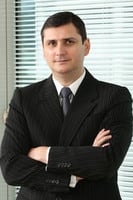PureCircle, the Malaysia-based stevia supplier, is in the process of scaling what its chief executive describes as the “next generation stevia”.
“Based on StarLeaf this new variety allows us to produce a lot larger molecules. This leaf is going to be phasing out all High Reb[audioside] A leaf over the next three years,” Malsagov explained.

“The beauty of this leaf is the ingredients we produce will allow [customers] to reduce 100% sugar with great taste.”
While this could be achieved previously, attempts to do so gave rise to “taste issues”. But the new StarLeaf offers “a very superior taste”, Malsagov claimed.
The company is planting this leaf across its plantations in South America, the US, East Africa, China and India.
The investment comes as PureCircle steps up efforts to strengthen its sales mix and increase its revenue from higher margin ingredients solutions. As part of this initiative, PureCircle revealed earlier this month that it is also launching the Sigma X-celerator, a new tool that aims to deliver customised ingredient solutions to its food and beverage customers.
“We are phasing out all… commodity type products and moving towards value-added breakthrough customized solutions that drive higher margins,” Malsagov said. “We have moved away from individual single molecules, a buy and sell approach, toward customized solutions [to deliver] formulations that are cost-effective and allow greater calorie reduction.”
Local production for local tastes
Malsagov noted that PureCircle’s customers all over the world are looking at sugar reduction. However, he stressed, to achieve this, companies must work at a local level to reflect local tastes.
“The taste is very much tailored to different markets because somebody in the East will have a very different taste profile for somebody in the West. Even for the same branded products.”
PureCircle operates seven innovation laboratories in markets such as the US, Mexico, India, the UK and Shanghai.
“Whether it is taste, or cost, or what level of calorie reduction, [the objective of the reformulation] is different for each brand, customer and region. So all of our labs are very busy with our clients’ formulations, helping them to launch the right tasting, right cost products. These solutions are not straightforward, single ingredient products. They are very customized and all of them are high margin.”
The company also plans to develop its stevia production footprint at a local level. While PureCircle is yet to make any formal announcements, it is working on a mid- to long-term plan that will see it process stevia leaf in North and South America, East Africa and India, Malsagov revealed.

Putting US ban in the past
PureCircle booked a decrease in full-year sales and earnings last week, due to major disruption in the US market.
For 12 months ending 30 June, pretax profit was $7.7m, down from $17.9m the year before, on revenue of $118.9m, down from $138.6m.
Between June and January, the US banned imports of PureCircle products alleging that the company had used slave labour. After a "forensic" analysis of the group's production processes, the ban was lifted and the allegation was dropped. But the issue nevertheless trimmed $30-35m off the top line, finance chief Rakesh Sinha told FoodNavigator.
The incident also dented profit margins with adjusted operating profit slipping from $33.2m to $17.6m. The reason for this, Sinha explained, is that the US is a higher margin business.
“The products that normally sell into the US are high margin products. So not being able to sell for those eight months caused us some margin pressure,” he said. “We're obviously trying to recover volume because we do want to fight back in terms of the ground that we lost. So clearly we've also had some moderation in prices to get some volume.”
Sinha remains upbeat about PureCircle's ability to fight back in the US.
“That problem was resolved in January this year and we were cleared of all allegations. We look forward. We are back on building that business again and recovering that business.
"Growth will come back in the next calendar year because obviously there is an innovation cycle that we need to catch and hopefully we'll catch that towards the end of this year. The results will come through in calendar year 2018.”
Naturalness and the sugar reduction mega-trend
Demand-growth for stevia is underpinned by what Malsagov describes as “a big fundamental structural shift” to reduce sugar consumption globally.
“A lot of food and beverage companies have publicly committed to lower sugar to WHO [World Health Organisation] guidance. Stevia or not, PureCircle or not, sugar is going down. Consumers and therefore customers desire to lower that naturally if they can.”
Malsagov observed that there are numerous “zero calorie, good tasting solutions” that are “dirt-cheap”. However, he stressed, these more cost-effective sugar substitutes utilise artificial sweeteners. Adding these to a company’s ingredients list goes against the groundswell in consumer demand for clean labels and natural ingredients.
Malsagov also believes natural stevia has health advantages over artificial sweeteners.
“When it comes to stevia, because it is natural, the way our body digests it is pretty much like any natural ingredient. It breaks down and it leaves our body pretty much as any other natural ingredients you use. With some artificial sweeteners, that mechanism is a little confusing because the body does not recognize certain molecules. They either do not degrade or stay in the body.
"As far as we know [based on] the research that we have done and public data available on Stevia… it is a very straightforward ingredient. The only difference between this and sugar in terms of in terms of chemistry is sweetness. That is all. You use 400 times less stevia than sugar. But the way body digests that is exactly the same.”
Stealthy sugar reduction
Malsagov observed that – while more and more food makers are reformulating their products – consumers are still sceptical about efforts to cut sugar from the ingredients list. As a result, he forecasts an increased number of “silent reformulations”.
The chief executive explained: “You will see a lot of sugar reduction when customers don't talk about it. They will just reduce sugar and leave consumers to ask questions if they have any.
“Silent reformulation is the way forward I see and our pipeline confirms the same. If I look at that pipeline that we have today, we have a lot of reformulations of core brands in our pipeline across the world and we expect a lot of them to be a silent reduction.”
This does not undermine the importance of claims that can be made about stevia’s naturalness, he continued. “Even if you didn’t talk about [the change] initially you still need to explain eventually and this is where natural becomes important. Yes, we reduced sugar but we did it using natural sweeteners and natural ingredients.”
Jury out on fermented stevia
For this reason, PureCircle is taking a ‘wait-and-see’ approach to the much-hyped commercial development of fermented stevia.
“The issue with alternative technologies, whether it is fermentation or biotransformation, unfortunately you lose that natural reason why consumers want the ingredient. You suddenly cook the ingredient in a reactor rather than grow in the field and extract it from the leaf. How consumers will perceive this ingredient is an open question really.”
An additional complication arises from the process’s use of GM technology. “You cannot produce fermented stevia without genetically modified yeast. How that will impact consumer perception and how that will play in terms of regulatory landscape, all these questions are still open.”
Malsagov believes that all these uncertainties mean it is not currently the best time to invest in fermentation technology. “Without knowing what the market potential is one cannot scale the technology. You cannot build a facility without knowing what the market potential is. I don't think technology cost-wise is there yet.”
Monkfruit not viable
Monkfruit is another natural sweetener that has caught the public imagination. However, Malsagov does not view the ingredient as a competitor for stevia, primarily because production is not scalable.
“We do not see any alternative natural sweetener as being commercially palatable. Let me explain what I mean by palatable. It needs to have a taste, it needs to have scale, availability, it needs to have cost and supply chain.
“Monkfruit is an OK ingredient. I wouldn't say is a fantastic ingredient in terms of taste but it is acceptable. But unfortunately, it grows in China on a particular mountain at a particular angle to the sun. It is very difficult to scale it. And it's very difficult to get the cost because the content of these molecules that makes it sweet are very small. It is a nice tool but it will not be a main driving force to reduce calories. I can tell you that much. There is no alternative to stevia in the foreseeable future.”
